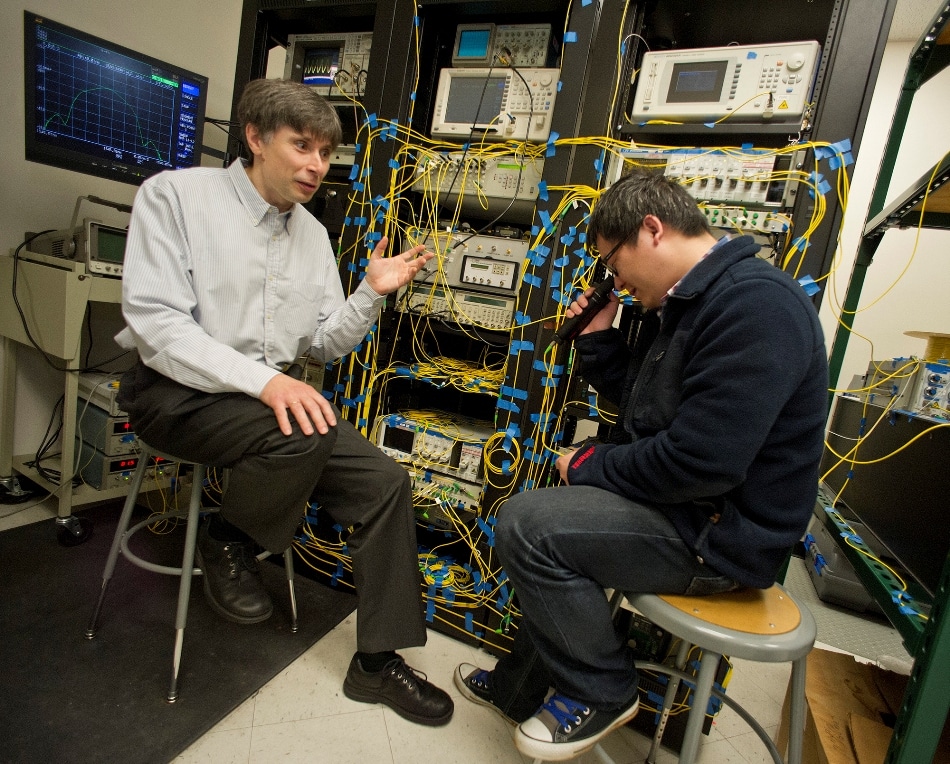Nov 1 2018
It is highly secure to distribute information through quantum communication since it is dependent on the quantum nature of single photons, or basic particles of light, to render it impossible for anyone to eavesdrop and extract information.
 Michael Vasilyev, UTA professor of electrical engineering, is using an NSF grant to address the challenges of large-scale deployment of quantum communication systems by developing chip-integrated devices and sub-systems for preparation and detection of quantum photonic signals. (Image credit: UT Arlington)
Michael Vasilyev, UTA professor of electrical engineering, is using an NSF grant to address the challenges of large-scale deployment of quantum communication systems by developing chip-integrated devices and sub-systems for preparation and detection of quantum photonic signals. (Image credit: UT Arlington)
Yet, quantum communication is also considerably slower compared to conventional means of communication and is challenging to deploy on a large scale.
Recently, Michael Vasilyev, a UTA professor of electrical engineering, and his research partner, Professor Yuping Huang of the Stevens Institute of Technology, received a three-year, $750,000 National Science Foundation grant to overcome the difficulties of large-scale deployment of quantum communication systems by creating chip-integrated devices and sub-systems for the preparation and detection of quantum photonic signals.
The award is part of $31 million awarded by the NSF for fundamental quantum research. Six million has been set aside for eight projects like Vasilyev’s project that allow scalable quantum communications systems by demonstrating proof-of-concept technologies that outperform innovative devices, information processing techniques, circuits, and integration platforms in a quantum communication system, according to the NSF.
Vasilyev and Huang have partnered earlier on a study to create photonic device technology that could considerably accelerate quantum communications.
For this grant, the researchers will integrate linear and nonlinear optical devices on a lithium-niobate thin film platform, rendering it feasible to reduce the size of an entire system down to a single chip. This will allow robust, fast, and photon-efficient quantum communications over both conventional telecom fibers and free space. While free space, or line-of-sight, systems enable quantum communication through satellite, fiber systems support communication via buried optical cables.
Although classical communications systems have the potential to transmit information at a rate of hundreds of terabytes per second, quantum communications are several orders of magnitude slower since they are dependent on single photons and it is not possible to apply amplifiers to the signal without compromising the secure nature of the transmission. This study will endeavor to develop an integrated quantum transceiver with the ability to both send and receive the quantum information over various temporal modes represented by different waveforms overlapping in time.
On the transmitter side, the scientists will encode information on a single photon with the help of lossless shaping of the photon waveform on a picosecond, or one-trillionth of a second, timescale. Lossless property suggests that there is no loss of energy from the waveform during the process.
This transmission system will provide the photon with a lot of liberty in the choice of its waveform that travels through the system, and it is possible to use each of these degrees of freedom to convey the information.
Mode-discriminating photon detection will be used by the receiver side, thereby dynamically choosing the mode from which the information will be extracted with a very high accuracy.
“Creating a quantum transceiver will yield the most important building block for future quantum communications systems that are robust against poor weather conditions, ultra-efficient for encoding and decoding of single photons and optimized for use over both free space and optical fiber,” stated Vasilyev. “If we are successful, it could be an important step in building large-scale quantum communication networks.”
Vasilyev’s study is an example of data-driven discovery, one of four themes of UTA’s Strategic Plan 2020: Bold Solutions | Global Impact, stated Jonathan Bredow, chair of the Electrical Engineering Department.
“Dr. Vasilyev has conducted extensive research into efficient, secure quantum communications, and his discoveries will fit well in the scope of this new grant. If successful, this team’s work would ensure the United States’ continued leadership in quantum communication technology,” stated Bredow.